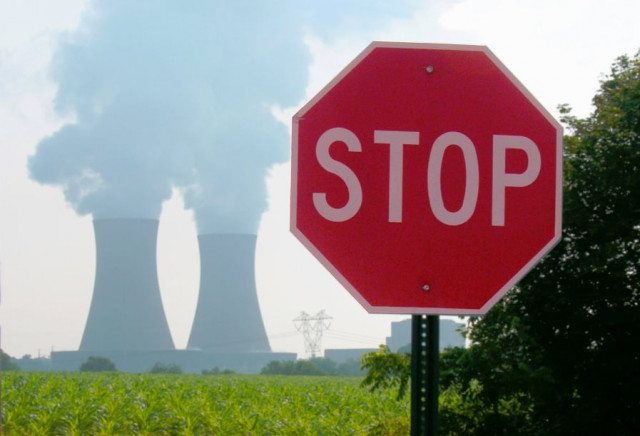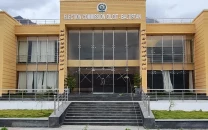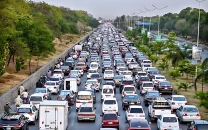Power crisis: ‘Untested’ proposed N-plants worry top nuclear scientists
Physicists recall Fukushima disaster, voice fears relating to onsite disasters; project staff disagrees.

‘Untested’ proposed N-plants worry top nuclear scientists. PHOTO: FILE
Some of those concerns were expressed on Saturday by eminent physicists and academics Dr Pervez Hoodbhoy and Dr AH Nayyar at a talk on nuclear energy in connection with the two new reactors being installed in Karachi. The talk was organised at Kuch Khaas by Subhenau, a non-government organisation that works on environmental issues.

Both speakers highlighted their apprehensions about the $9.6 billion power project on the Karachi coast, which would use two Chinese-made 1,100 Megawatt ACP-1000 nuclear reactors and is partly financed by a $6.5 billion loan from the Chinese government.
Planning for the project began in 2006 and site work started in October 2013, according to the Pakistan Atomic Energy Commission (PAEC), but it did not attract controversy or public debate until it was inaugurated by Prime Minister Nawaz Sharif in November 2013.
Since then, civil society organisations have expressed alarm over the development, evoking the 2011 Fukushima Daiichi nuclear disaster in Japan. Tsunami waves caused by a massive earthquake indirectly damaged nuclear reactors at Fukushima and led to the leakage of both radiation in to the atmosphere and radioactive water in to the Pacific Ocean.
Hoodbhoy and Nayyar maintained that nuclear power plants are prone to accidents, often due to human error, and have unique causes that make preempting them nearly impossible.
Given this, putting the reactors in operation close to a densely populated area without proper testing or adequate safety and security protocols might be extremely risky, they said.
A contingent of PAEC representatives including the Karachi project’s director Azfar Minhaj attended the talk and defended the project’s location and reactor design during the discussion afterwards.

Hoodbhoy said he was principally neutral towards using nuclear power for electricity generation but said he was “not ambivalent about the seeds of enormous catastrophe [sown] in this deal with China.”
He said the nuclear power plant on the Karachi coast could be endangered by seismic activity, develop technical faults or even be targeted by militants. If any of those extreme developments happen, the wind could carry the radiation towards Karachi city, according to Hoodbhoy.
“Can you order an evacuation of Karachi?” Hoodbhoy said. “My worry is you cannot evacuate Karachi.”
He said he might drop his objections if the location of the project is changed, but PAEC officials told The Express Tribune that they were satisfied with the site and it was selected after studies that involved looking at seismic history, hydrology and cooling water availability among other factors.
Nayyar, who said he has studied some documents of the project including the official site evaluation report, said the project uses an “untested” Chinese reactor.
“The reactor is being developed for the first time and when it becomes operational in Pakistan, it will not have a history of being run,” Nayyar said.
Nayyar said the Chinese are installing ACP-1000 reactors in their own country but they have imported some components for their own reactors from French and Japanese companies.
However, he said, the Chinese cannot provide those imported components to Pakistan because of a proliferation-related restriction imposed on Pakistan by the Nuclear Suppliers Group (NSG) — an unofficial body of countries that controls trade of nuclear material that could be used to make weapons.
This leads to a bizarre arrangement where the Chinese will provide Pakistan Chinese-manufactured versions of the components they themselves have imported, according to Nayyar.
He said Pakistan should wait a few years to see if the reactor works in China before using it.
Nayyar also mentioned that a major reason for the rush by Pakistani authorities to build this plant could be that China is bypassing NSG restrictions and is also financing the project. China, he said, has a strong industry that needs to market its products, but no one except Pakistan is willing to buy their reactors.
Minhaj, the PAEC project director, claimed there was “nothing new” about the reactor design or reactor control except “passive safety features.” The Atomic Energy officials also said they have an evacuation zone stretching around a 15-km radius from the reactor.
The speakers said the worst possible scenario needs to be considered, but PAEC officials suggested no project can go through if such hypothetical situations are entertained.
Speakers and audience members also emphasised the need to opt for renewable and alternative energy sources ahead of nuclear energy to overcome the country’s power crisis.
They also stressed that PAEC should do case studies on the way its existing nuclear power plants at Chashma have affected the local irrigation and fisheries sectors.
Subhenau CEO Dr Jawad Chistie, who moderated the talk, said his organisation was opposed to the project because of the negative health effects on populations residing near nuclear power plants including an increased risk of leukemia.
“Such measures should be well thought out rather than being regretted later,” Chishtie said.
Published in The Express Tribune, February 3rd, 2014.



















COMMENTS
Comments are moderated and generally will be posted if they are on-topic and not abusive.
For more information, please see our Comments FAQ